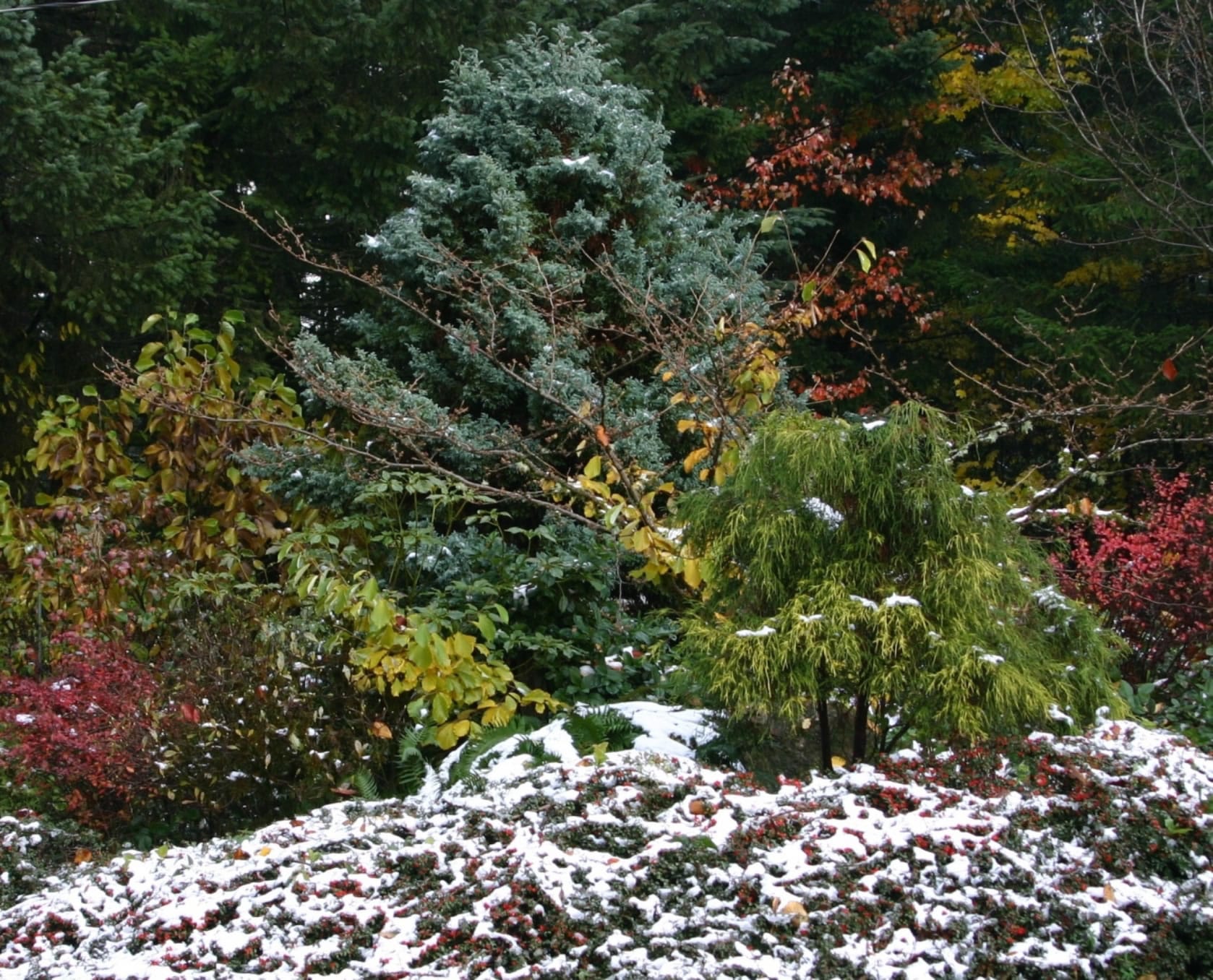New Year’s Eve brought a bone-chilling reminder that January is a winter month. Temperatures dropped. There was a dusting of snow in Vancouver and an accumulation of several inches of snow up on my hill. By definition, winter is the coldest season of the year, extending from the end of autumn to the beginning of spring. Extremely cold weather comes and goes, but when it is present, it consumes our attention. Today, cold is all I can think about.
There is no better time than midwinter to determine the value of adding evergreen plants to your garden. In spring and summer, evergreens serve as solid, structural back drops in the garden. Unless they are planted in a prominent position as a specimen plant, they often meld into the background. A planting of seasonal perennials pops with color and takes center stage when backed up to an evergreen hedge. Most colors appear clear and vibrant against the dark green of the English Yew (Taxus baccata).
In winter, however, these evergreens become the most visible features in the garden. The weight of their presence is obvious when the last of the flowering perennials die down and deciduous trees lose their foliage. In winter, we clearly see the unique form, shape and leaf tex
ture of these once-demure evergreens. Fortunately for us, a wide variety of broadleaf evergreen shrubs and needled conifers grow to perfection in our soil and climate.
Plant growers continue to cultivate new varieties every year. The vast selection of evergreens available to us grows ever more abundant. By January, deciduous trees have shed their leaves, displaying the graceful form of bare branches. Following this act of nature, evergreens become particularly prominent in the landscape. A sampling of plants available to us includes an array of Northwest natives such as rhododendron, salal (Gaultheria spp.), Oregon grape (Mahonia spp.) and Vaccinium ovatum, the evergreen Huckleberry.
Every year, new colors are added to the once all-green family of needled evergreen plants. Golden-yellow varieties add life to a winter border. Take any established plant from the Hinoki cypress to a basic arborvitae and you will find a variety with ‘Aurea’ added to the name to denote its yellow coloration. I doubt it’s the end of the color parade either, as more and more blues, reds and myriad shades of green join the evergreen spectrum.
Having planted dozens of conifers in the garden over the last ten years, I can attest to their value in the winter garden. In the eyes of a plant lover, each variety is unique and worth planting for their individual features. I love the architectural form of spruce and pine and the rich, emerald green color of the false cypress family. This group is listed in plant dictionaries as Chamaecyparis, which includes the large group of plants known as Hinoki False Cypress.
Take advantage of this barren season to plant deciduous trees with distinct bark color and texture. The European whitebark birch (Betula utilis ‘Jacquemontii’) is breathtaking. Jacquemontii has the brightest white bark and displays a graceful, open-branched form. It has a good display of yellow fall color as well.
Its stunning brother, the River Birch (Betula nigra) has cinnamon-brown bark that flakes and curls in translucent sheets. A single, clump-forming birch will have multiple trunks to show off its bark but won’t overwhelm a mid-size garden. If you have a large property with rocky, well-drained soil in full sun, plant a stand of Aspen for their ghostly gray winter bark.
Only in the midst of winter will we find the Dawn viburnum (V. bodnantense) in full flower, with tiny bundles of sweet blooms the color and scent of cotton candy. At the corner of my driveway dogleg, the arthritically twisted, tiny fingerlike blossoms of the witch hazel ‘Jelena’ (Hamamelis intermedia) are quite lovely on closer inspection, with petals shooting out of leafless branches in metallic colors of orange, bronze, and copper.
The buds of assorted sasanqua camellias are fat to bursting with red, white or sea shell pink blossoms. Other winter plant bonuses include the fascinating array of newly introduced Heavenly Bamboo (Nandina domestica) in many colorful, dwarf varieties. On a dreary day in winter, the Evergreen Huckleberry will stand out with leathery, lustrous dark green leaves featuring red and bronze highlights. Like its relative Red Huckleberry, it’s native to the region. Its thin, green branches form an intricate winter silhouette and it’s as easy to grow as it is reliable.
Robb Rosser is a WSU-certified master gardener. Reach him at Write2Robb@aol.com.



